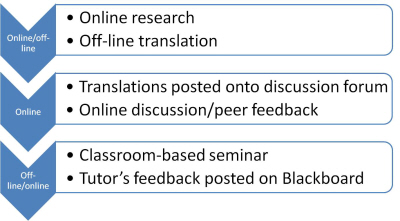Elena McNeilly, elena.mcneilly@bristol.ac.uk
This pilot initiative involved a move from traditional classroom-based delivery of a second-year undergraduate English/Russian translation unit to a blended learning approach. The blended model in question was developed primarily to respond to students’ needs, but also to address broader organisational needs through exploring an effective mechanism of peer assessment in large translation classes while at the same time achieving a higher quality of work. One of the academic goals was to create ‘a sustained community of inquiry that extends beyond limited classroom opportunities and to reduce lecturing while increasing inquiry and discourse’ (Garrison and Vaughan, 2007: 72).
The primary objective was to show the students that they can learn about translation not only in class but also through conducting research online and by interacting with the other members of the group using the discussion forum on Blackboard. Students were encouraged to develop translation strategies, to use a variety of internet-based language resources and to learn to evaluate their own and other students’ work. Another objective was to help learners in enhancing their critical and reflective skills. An essential element of the course is peer feedback on each other’s work through online interaction: pointing out successful solutions and making suggestions on issues they would have handled differently. This contributes to the development of important employability skills, including working as part of a team and critical thinking.
The course was traditionally delivered via a fortnightly one-hour seminar, supported by the distribution of extensive handouts. This was (and still is) followed by an assessed translation in the summer. Students were asked to translate into Russian and submit eleven handwritten practice pieces per academic year. Classroom discussion was based on the analysis of students’ translation of the source text. At times, this was dominated by the same five or six individuals as less confident students avoided taking part in discussions. Sometimes students couldn’t attend the seminar and therefore missed out on feedback, as the final version of the translation was agreed in class.
In addition to the fortnightly face-to-face seminars, online structured activities were set up in a blended model. Littlejohn and Pegler state that the word ‘blended ‘ implies ‘a seamless integration or intermingling of e-learning and conventional teaching approaches’ . They suggest wrapping one approach around another, for example using conventional teaching to wrap around e-learning resources , or extending traditional approaches by wrapping these around e-learning activity. (Littlejohn and Pegler, 2007: 30) The chosen structure for this unit is illustrated below. This sequence was repeated in a fortnightly cycle.

The tutor initially had to invest time setting up the course on Blackboard, and providing a clear structure and instructions for students on how and when to complete the various activities. The tutor also provided resources which included previous examples of students commenting on each other’s work. This illustrated ways of providing constructive criticism. Once the unit had begun she took the role of e-moderator, providing guidance and encouragement through the online discussion fora. Key to this was maintaining an online presence, for example by posting reminders of due dates, and recognising areas which students found tricky and highlighting that these would be explored further in the classroom sessions. This reinforced the link between the online and face-to-face components of the course, ensuring that students did not regard the online elements as “add-ons” but saw that they were an important and valuable part of their learning which always linked in to their class time. (For examples of the e-moderator’s online contributions see below).
Having reviewed student feedback as well as reflected on her own experience, the tutor has concluded that this was an extremely beneficial change. The students developed a better awareness of what is expected of them in assessed assignments. They improved translation skills and enhanced their knowledge of grammar and vocabulary. Their communication skills and ability to analyse their own and other students’ work have significantly improved. They also became much more confident in using online resources and conducting pre-translation research through learning from each other. In the course evaluation, students were asked “ In comparison to standard classroom-based courses, what was the most effective aspect of this blended learning course?” Responses included:
The tutor reflects that the course did require an inital investment of time to set up, and some additional time to oversee the online discussion. However, now she is able to easily re-use the course, and also feels that she has become more efficient at “e-moderating” as her experience has increased. Overall she feels that the re-design of the course has been extremely positive as it has improved student learning.